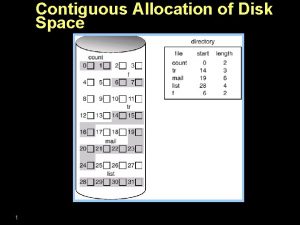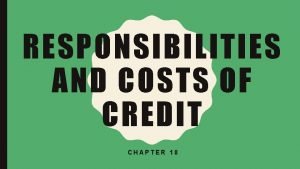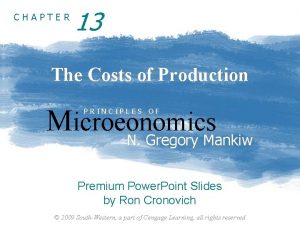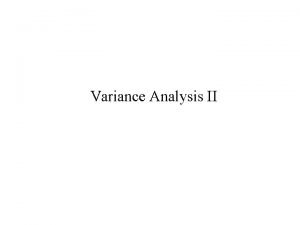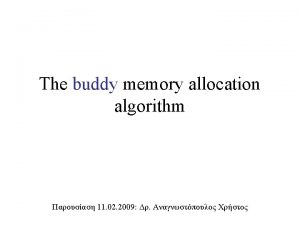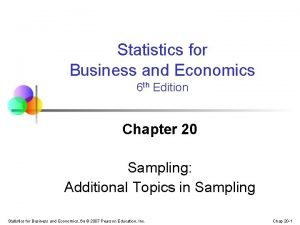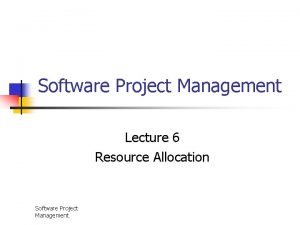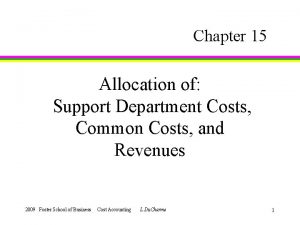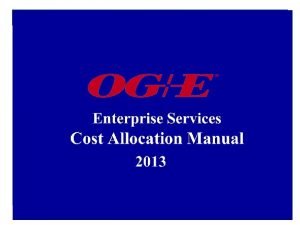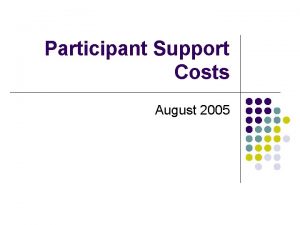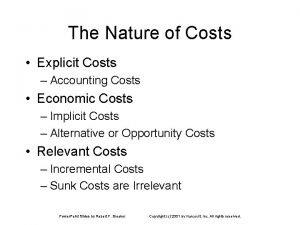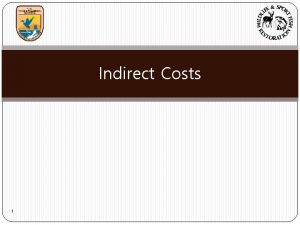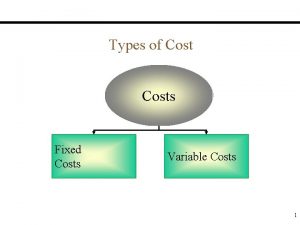CHAPTER 15 Allocation of Support Department Costs Common




















- Slides: 20

CHAPTER 15 Allocation of Support Department Costs, Common Costs, and Revenues To accompany Cost Accounting 12 e, by Horngren/Datar/Foster. Copyright © 2006 by Pearson Education. All rights reserved. 15 -1

Allocating Costs of a Supporting Department to Operating Departments Supporting (Service) Department – provides the services that assist other internal departments in the company Operating (Production) Department – directly adds value to a product or service Most companies believe that fixed costs of support departments should be allocated because they were incurred to provide operating divisions with the services they require. To accompany Cost Accounting 12 e, by Horngren/Datar/Foster. Copyright © 2006 by Pearson Education. All rights reserved. 15 -2

Methods to Allocate Support Department Costs Single-Rate Method – allocates costs in each cost pool (service department) to cost objects (production departments) using the same rate per unit of a single allocation base No distinction is made between fixed and variable costs in this method To accompany Cost Accounting 12 e, by Horngren/Datar/Foster. Copyright © 2006 by Pearson Education. All rights reserved. 15 -3

Methods to Allocate Support Department Costs Dual-Rate Method – segregates costs within each cost pool into two segments: a variable-cost pool and a fixed-cost pool. Each pool uses a different cost-allocation base To accompany Cost Accounting 12 e, by Horngren/Datar/Foster. Copyright © 2006 by Pearson Education. All rights reserved. 15 -4

Allocation Method Tradeoffs Single-rate method is simple to implement, but treats fixed costs in a manner similar to variable costs Dual-rate method treats fixed and variable costs more realistically, but is more complex to implement To accompany Cost Accounting 12 e, by Horngren/Datar/Foster. Copyright © 2006 by Pearson Education. All rights reserved. 15 -5

Allocation Bases Under either method, allocation of support costs can be based on one of the three following scenarios: 1. 2. 3. Budgeted overhead rate and budgeted hours Budgeted overhead rate and actual hours Actual overhead rate and actual hours Choosing between actual and budgeted rates: budgeted is known at the beginning of the period, while actual will not be known with certainty until the end of the period To accompany Cost Accounting 12 e, by Horngren/Datar/Foster. Copyright © 2006 by Pearson Education. All rights reserved. 15 -6

Methods of Allocating Support Costs to Production Departments 1. 2. 3. Direct Step-Down Reciprocal To accompany Cost Accounting 12 e, by Horngren/Datar/Foster. Copyright © 2006 by Pearson Education. All rights reserved. 15 -7

Direct Method Allocates support costs only to Operating Departments No interaction between Support Departments prior to allocation To accompany Cost Accounting 12 e, by Horngren/Datar/Foster. Copyright © 2006 by Pearson Education. All rights reserved. 15 -8

Direct Method To accompany Cost Accounting 12 e, by Horngren/Datar/Foster. Copyright © 2006 by Pearson Education. All rights reserved. 15 -9

Step-Down Method Allocates support costs to other support departments and to operating departments that partially recognizes the mutual services provided among all support departments One-way interaction between Support Departments prior to allocation To accompany Cost Accounting 12 e, by Horngren/Datar/Foster. Copyright © 2006 by Pearson Education. All rights reserved. 15 -10

Step-Down Method To accompany Cost Accounting 12 e, by Horngren/Datar/Foster. Copyright © 2006 by Pearson Education. All rights reserved. 15 -11

Reciprocal Method Allocates support department costs to operating departments by fully recognizing the mutual services provided among all support departments Full two-way interaction between Support Departments prior to allocation To accompany Cost Accounting 12 e, by Horngren/Datar/Foster. Copyright © 2006 by Pearson Education. All rights reserved. 15 -12

Reciprocal Method To accompany Cost Accounting 12 e, by Horngren/Datar/Foster. Copyright © 2006 by Pearson Education. All rights reserved. 15 -13

Choosing Between Methods Reciprocal is the most precise Direct and Step-Down are simple to compute and understand Direct Method is widely used To accompany Cost Accounting 12 e, by Horngren/Datar/Foster. Copyright © 2006 by Pearson Education. All rights reserved. 15 -14

Allocating Common Costs Common Cost – the cost of operating a facility, activity, or like cost object that is shared by two or more users at a lower cost than the individual cost of the activity to each user To accompany Cost Accounting 12 e, by Horngren/Datar/Foster. Copyright © 2006 by Pearson Education. All rights reserved. 15 -15

Methods of Allocating Common Costs Stand-Alone Cost-Allocation Method – uses information pertaining to each user of a cost object as a separate entity to determine the cost-allocation weights Individual costs are added together and allocation percentages are calculated from the whole, and applied to the common cost To accompany Cost Accounting 12 e, by Horngren/Datar/Foster. Copyright © 2006 by Pearson Education. All rights reserved. 15 -16

Methods of Allocating Common Costs Incremental Cost-Allocation Method ranks the individual users of a cost object in the order of users most responsible for a common cost and then uses this ranking to allocate the cost among the users The first ranked user is the Primary User and is allocated costs up to the costs of the primary user as a stand-alone user (typically gets the highest allocation of the common costs) The second ranked user is the First Incremental User and is allocated the additional cost that arises from two users rather than one Subsequent users handled in the same manner as the second ranked user To accompany Cost Accounting 12 e, by Horngren/Datar/Foster. Copyright © 2006 by Pearson Education. All rights reserved. 15 -17

Revenue Allocation and Bundled Products Revenue Allocation occurs when revenues are related to a particular revenue object but cannot be traced to it in an economically feasible manner Revenue Object – anything for which a separate measurement of revenue is desired Bundled Product – a package of two or more products or services that are sold for single price, but individual components of the bundle also may be sold as separate items at their own “stand-alone” prices To accompany Cost Accounting 12 e, by Horngren/Datar/Foster. Copyright © 2006 by Pearson Education. All rights reserved. 15 -18

Methods to Allocate Revenue to Bundled Products Stand-Alone (separate) Revenue Allocation Method uses product-specific information on the products in the bundle as weights for allocating the bundled revenues to the individual products. Three types of weights may be used: 1. Selling Prices 2. Unit Costs 3. Physical Units To accompany Cost Accounting 12 e, by Horngren/Datar/Foster. Copyright © 2006 by Pearson Education. All rights reserved. 15 -19

Methods to Allocate Revenue to Bundled Products Incremental Revenue-Allocation Method ranks individual products in a bundle according to criteria determined by management and then uses this ranking to allocate bundled revenues to individual products (similar to earlier discussed Incremental Cost-Allocation Method) The first-ranked product is the primary product The second-ranked product is the first incremental product The third-ranked product is the second incremental product, etc. To accompany Cost Accounting 12 e, by Horngren/Datar/Foster. Copyright © 2006 by Pearson Education. All rights reserved. 15 -20
 Support department adalah
Support department adalah Linked allocation
Linked allocation Major and minor ideas
Major and minor ideas Chapter 18 responsibilities and costs of credit
Chapter 18 responsibilities and costs of credit Chapter 5 section 2 costs of production
Chapter 5 section 2 costs of production Chapter 13 the costs of production
Chapter 13 the costs of production Highest common factor of 12 and 42
Highest common factor of 12 and 42 Common anode and common cathode
Common anode and common cathode Factor tree for 72
Factor tree for 72 Factors of 54
Factors of 54 The gcf of 12 and 18
The gcf of 12 and 18 Highest common factors and lowest common multiples
Highest common factors and lowest common multiples Purchase price allocation pwc
Purchase price allocation pwc Variable overhead efficiency variance
Variable overhead efficiency variance Observable facts
Observable facts Buddy memory allocation implementation
Buddy memory allocation implementation Cloud cost allocation
Cloud cost allocation Capital allocation line
Capital allocation line Variance of population proportion
Variance of population proportion Spectrum allocation
Spectrum allocation Resource allocation in software project management
Resource allocation in software project management

